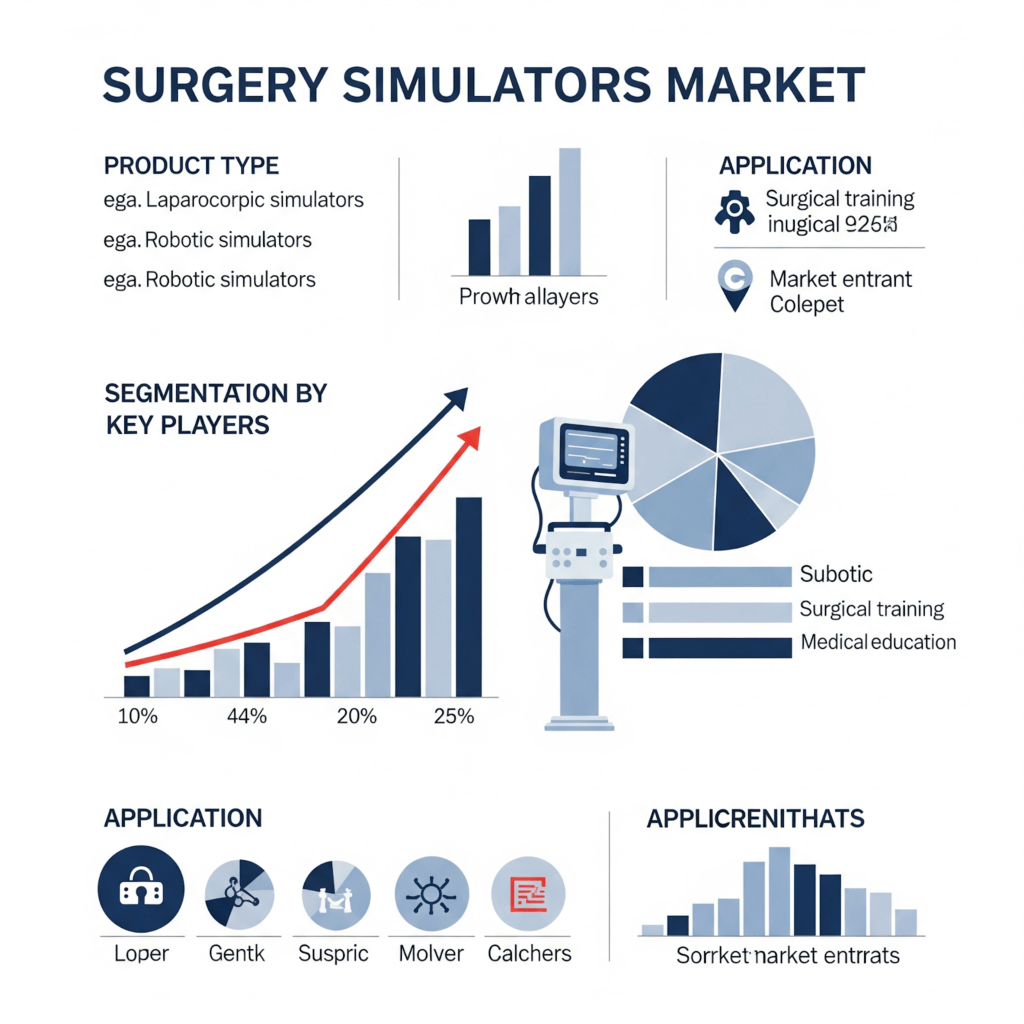Skill, Precision & Simulation | Trends & Forecast till 2035

Executive Insight
As healthcare continues to evolve toward precision, safety, and minimally invasive procedures, surgical simulation technologies have emerged as a transformative tool in both training and clinical practice. The Global Surgery Simulators Market is experiencing steady growth, driven by advancements in virtual reality (VR), increasing demand for surgical accuracy, and regulatory pressure for safer patient outcomes.
From novice residents to experienced surgeons mastering complex procedures, simulators bridge the gap between education and live surgery—without risking patient safety.
🔗 Quick Access:
View Full Report
Market Segmentation
🔷 By Product Type:
- Surgery Simulators – Broad-based platforms used for a variety of surgical practices.
- Joint Arthroscopy Simulators – Specialized for orthopedic training (note: listed twice in source).
- Puncture Simulators – Commonly used in emergency and critical care training.
- Laparoscopy Simulators – Highly sought in minimally invasive surgical training.
- Interventional Fluoroscopy Simulators – Essential for imaging-guided procedures like catheter placement and angiography.
🔷 By Application:
- Hospitals – Leading adoption due to residency programs and surgeon training needs.
- Clinics – Emerging use for outpatient surgical education and technique refinement.
- Others – Includes academic institutions, medical training labs, and simulation centers.
Regional Snapshot
🌎 North America
Leads the market due to structured residency training programs, simulation accreditation requirements, and early technology adoption.
🌍 Europe
Investments in simulation-based medical education are growing, especially in Germany, the U.K., and France.
🌏 Asia Pacific
Rapidly growing due to rising healthcare spending, medical tourism, and increased training needs in India, Japan, and China.
🌎 Latin America & Middle East & Africa
Market growth driven by modernization of healthcare infrastructure and international collaborations in medical education.
Market Drivers
- 🧑⚕️ Demand for zero-risk surgical training across healthcare education.
- 🕹️ Growth in AR/VR integration, providing real-life immersive scenarios.
- 🧪 Simulation mandates by surgical boards and licensing authorities.
- 📉 Reduction in hands-on surgical exposure due to patient safety standards.
- 🧠 AI-based training systems for real-time performance feedback and skill scoring.
Market Challenges
- 💲 High initial cost and maintenance of advanced simulators.
- 🔧 Need for regular software updates and hardware calibration.
- 🧑🏫 Lack of skilled instructors to supervise simulation-based curricula.
- 🧩 Limited adoption in developing economies due to cost constraints.
Future Opportunities
- 🤖 AI-driven simulators that adapt to individual surgeon skill levels.
- 🌐 Remote surgical training modules via cloud-based simulators.
- 🧬 Specialty-specific simulators for neurosurgery, robotics, and interventional radiology.
- 🧑⚕️ Gamification and skill certification integrated into hospital learning platforms.
Key Market Players
- Luneau Technology SAS
- Nidek Co Ltd
- Essilor Italia Spa
- Topcon Corporation
- Dia Optical
- MEI GmbH
- Huvitz Co., Ltd.
- Fuji Corporation
- Shanghai Supore Instruments Co., Ltd.
- Visslo Co., Ltd.
These firms are actively investing in 3D modeling, anatomically accurate haptics, and remote learning capabilities, making simulators smarter, faster, and more accessible.
Author Attribution
Authored by Riya B. More, Research Associate at Prophecy Market Insights.
This analysis is derived from a comprehensive mix of primary expert interviews, hospital simulation case studies, and secondary market intelligence, delivering a clear picture of how the Surgery Simulators Market is revolutionizing surgical education and patient care outcomes.
The macro analyst desk brings highly sought after financial news based on market analysis, insider news and company filings.
